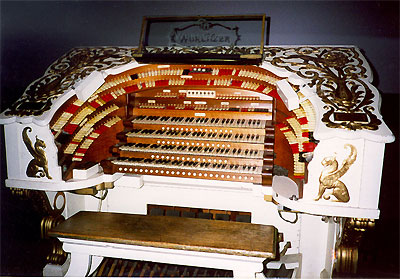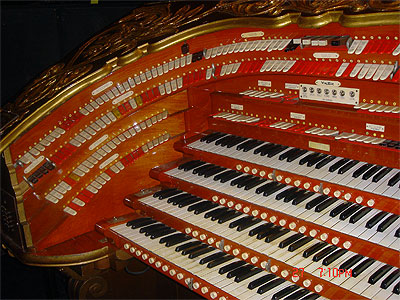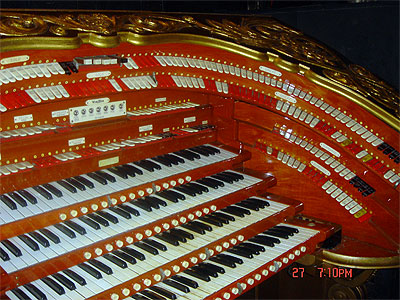
|
|
Saint Louis Fox Theatre's 4/36
|
|
The Saint Louis Fox Theatre was built in 1928 along with it's sister Fox Theatre in Detroit, Michigan. The two theatres are the last of the twin movies houses built during the silent move era. The theatres are absolutely spectacular. Restoration of the Saint Louis Fox began in 1980 as a group of local business people came to it's rescue. The Theatre re-opened in 1982. The Detroit Fox was also saved from the wrecking ball in 1986 and it's restoration was completed in 1988. The Fox Theatre seats 5,000 people. Both the Saint Louis Fox and the Detroit Fox were outfitted with Mighty WurliTzer Theatre Pipe Organs. These two organs, known affectionately as "Crawford Specials", are the only two remaining in their original homes out of five organs built of this type. The prototype was installed in the original Paramount Theatre on Manhattan Island. The Fox chain ordered four for their "Deluxe" houses in Detroit, St Louis, Brooklyn and San Francisco. Billed as "the inspiring $6 million William Fox temple of the motion picture," the Fox Theatre opened originally early in 1929. The decor, designed by William's wife Eve Leo, has been described as Siamese Byzantine. Reporters in 1929 said the theatre and it's Detroit twin were "awe-inspiringly fashioned after Hindoo Mosques of Old India, bewildering in their richness and dazzling in their appointments...striking a note that reverberates around the architectural and theatrical worlds." The Fox faced stiff competition from other theatres in the area, however, and in 1931 went into receivership. Fanchon and Marco took a 25 year lease on the building in 1934, and Harry Arthur became the General Manager, and over the years, the Arthurs gradually gained a controlling interest. Business continually declined, however, despite Arthur Enterprises' ultimately resorting to Kung Fu movies and occasional rock concerts to stay open. Finally, in 1978, the Fox closed. Banding together as Fox Associates, Leon Strauss, Robert Baudendistel, Dennis McDaniel and Harvey Harris privately purchased the Fox in 1981, and began a one year, $2 million plus restoration program, directed by Mary Strauss. A conscious effort was made to restore the theatre as closely as possible to its 1929 state of magnificence. Thousands of square feet of ornate plaster work were recreated on site, missing art glass was authentically reproduced, the magnificent 2000 pound chandelier in the auditorium was lowered, cleaned and re-lamped, missing brass fixtures were reproduced, and 7300 yard of carpeting were woven in the original elephant pattern. Even the 4/36 Mighty WurliTzer Theatre Pipe Organ, one of only five "Crawford Specials" ever built, was lovingly restored. Electrical systems were replaced, the leaking roof was repaired and eventually replaced, and serious plumbing and mechanical problems were overcome. In addition, the stage and backstage areas were completely transformed and updated to accommodate a wide spectrum of contemporary entertainment. Today the Fox plays host to a variety of year-round entertainment, including Broadway musicals, concerts and dance productions. The theatre is also available for rental for private functions. |
A Closer Look at the Console |
|
The Saint Louis Fox Theatre's 4/36 Mighty WurliTzer Theatre Pipe Organ is one of only five essentially identical instruments. Having 4 manuals, 36 ranks and 348 stops the "Crawford Special" has become almost a legend in the theatre organ world. Today, this WurliTzer Organ is one of only two surviving in their original homes, the other one being in the Detroit Fox Theatre, twin of the Saint Louis Fox. Since we have yet to aquire high quality close-up shots of the console, we are using two made at a sister console very simular to the Saint Lous installation, the San Fransisco Fox instrument. Notice the additional swell shade indicator at the top of the stop rail in the center of the top row. Also note the black finish of this console, where the one in Saint lous is white, a finish not original to the organ. In 1981, Marlin Mackley got the overwhelming task of bringing this great beast back to life. With a limited budget and time for that task, Marlin brought the Wurlitzer back to life. Since those early days Marlin has pretty much crawled, climbed and fallen in and out of every nook of the organ. Fortunately for him, with only minor scars to show for it (so far!). And now after several years of dormancy, the organ is again being heard again. This time during the theatre tours being played by none other than Stan Kann. Stan was the house organist for 22 years. Stan moved to Los Angles and worked there for 20 years. Stan moved back to Saint Louis area, to once again be seated as house organist. |
Music Downloads |
Stan KannThe 22 years as the house organist at the Fox Theatre in Saint Louis singles out Stan Kann as the longest running entertainment musician/organist in North America. Stan started playing on the "window sill" at the age of only four years while listening to the radio. He was immediately encouraged by his parents at the piano. Stan was at the organ console by the age of fourteen. While majoring in organ at Washington University in Saint Louis, Stan discovered the entertainment side of the organ. It was during this time that Stan was involved in the first restaurant with a pipe organ where he nationally broadcast every Saturday night on the NBC Radio Network. Stan is a world renowned theatre organist and comedian. He performs concerts around the world and is available for your group as a guest speaker or entertainer. He can be seen weekly during the theatre tours at the Fabulous Fox. If you do not live close to one of Stan's appearances you can still hear Stan on CD and Tape. See his music page to order CD's and Tapes.
|



